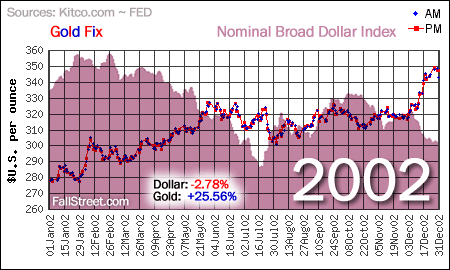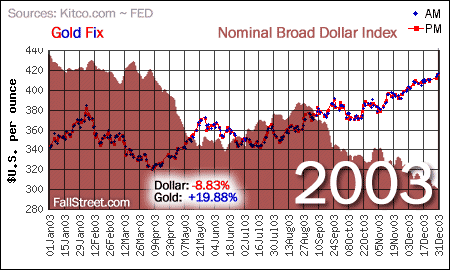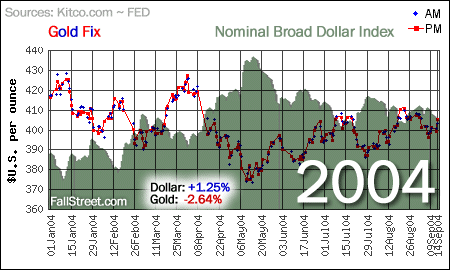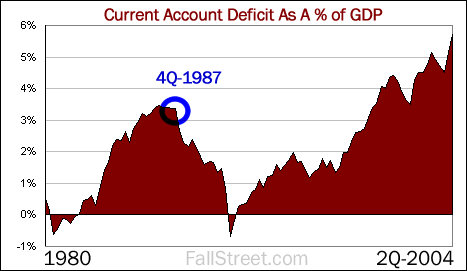September 15, 2004
Price of Gold Eyes December 3-Peat on 87-Style Dollar Instability
By Brady Willett
Leading into 2004 bond bear prophecies were popular, Wall Street was bullish on stocks, and nearly everyone was forecasting a further weakening in the greenback. Well, more than eight months into the year and the upset story is taking shape: stocks are trading near flat, the long bond is (barely) up, and the U.S. dollar is slightly higher against the Euro. As for the price of gold – you guessed it – the consensus called for strength and gold is weaker year to date.
Trying to decipher how each of these consensus contradicting developments will play out in the near term isn’t easy to do. Rather, with the Fed looking to tighten interest rates further and economic growth showing signs of moderating the immediate outlook for the financial markets is uncertain. However, longer term the fundamentals paint a decidedly different picture, especially when it comes to the U.S. dollar and POG. To be sure, as the mammoth U.S. current account deficit continues to grow – to a record 5.7% of GDP in 2Q04 – the ominous realization is that further dollar weakness is required to correct this unsustainable trend. Exactly when the dollar will be tripped up next no one can be exactly sure. However, given that OECD economists contend (report) that to narrow the deficit by 2 percent points over 6-years it would take a 25% drop in the dollar (against America’s major trading partners) – and other economists offer similar scenarios – one thing is certain: the next dollar down leg is likely to be deep enough to propel gold to 17-year highs.
Down But Not Out
After logging stellar gains in 2002 and 2003 gold has – taking an optimistic point of view – been consolidating above $400 an ounce in 2004. The pessimistic conclusion is that the multi-year strong gold/weak dollar trend in place leading into 2004 has been broken (this is a difficult conclusion to grab onto given lack of fundamentals currently supporting the dollar).
 |
 |
 |
Why Is 1987 Relevant To The POG?
In 1987 the U.S. current account deficit was rising, interest rates were rising, and the outlook for the dollar – from a policy standpoint – was confusing. Suffice to say, exactly why Wall Street suffered its worst market crash in history nearly 17-years ago is open for debate (failure of portfolio insurance, trades not cleared, Baker, etc). What is not debatable is that U.S. dollar weakness/instability was one the key trigger events.
 |
Beyond the fundamental comparisons between 1987 and today, the other reason why 1987 is important with regards to the POG is because it is an example of how quickly confidence in the U.S. dollar can crumble, and/or how quickly gold can rally. Leading into the crash former Treasury Secretary James Baker III hinted that the dollar’s decline would not be supported and Greenspan, also hinting about dollar devaluation, gave his first and last interview to Fortune. These ‘hints’ dramatically changed investor sentiment (Wanniski).
1987 Versus Today
Instead of The Louvre accord we have G7 meetings declaring currency ‘flexibility’. Instead of Baker attacking Germany’s currency regime we have Snow attacking China’s currency regime. Instead of Greenspan…well, we still have Greenspan.
As for rising current account deficits, interest rates, and a confusing dollar outlook from a policy standpoint -- check, check, and – maybe also - check.
Why ‘maybe’? Because although policy makers since the crash of 87 have adopted a more united dollar position – i.e. Rubin’s ‘strong dollar is in the best interests of America’ – some threatening trends have recently arrived. For example, over the last week Fed’s Pianalto and Guynn said that interest rates must rise, Fed Bies said that there is no hurry to raise interest rates, and demand for 10-year securities (at govt auction) dropped to the lowest since March. These events hardly foretell of a dollar collapse, but they do hint of policy indecision. However, given that investor sentiment is partially irritated/influenced by policymakers and fundamentals (i.e. an unsustainable 5.7%), the speculation is that dollar looks increasingly likely to become unstable.
Conclusions
Making sense of the consensus contradictions in 2004 isn’t easy. In fact, there is only one way not to get caught up in the game of fantastic specu